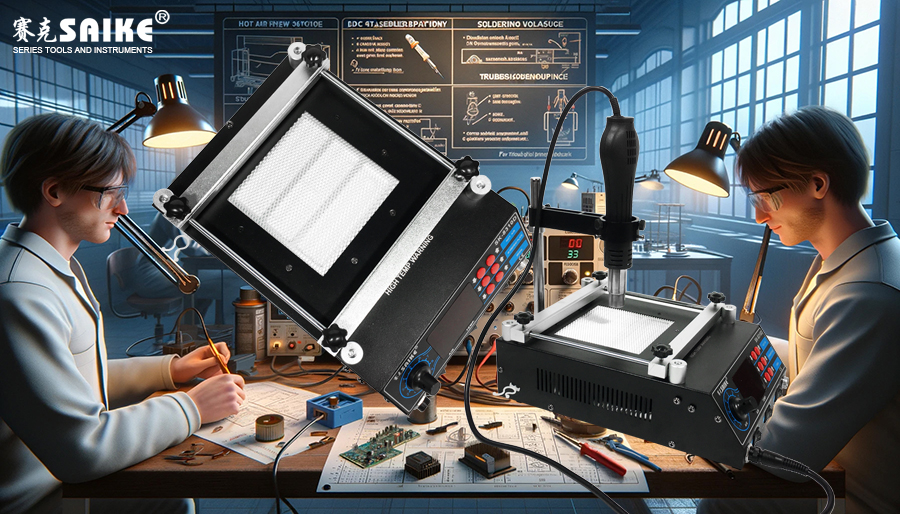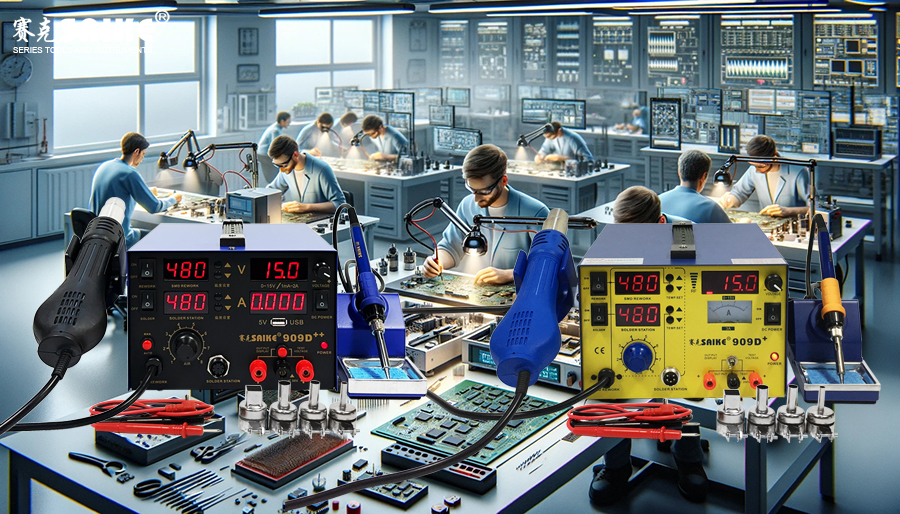
SK-YJ000RFSHY-KP 100047
In electronic component desoldering and circuit repair, hot air rework stations, soldering stations, and DC stabilized power supplies are essential tools. Although these tools are powerful, various problems and challenges still arise during practical operation. This article will share some troubleshooting techniques and experiences to help improve operational efficiency and repair quality.
I. Techniques and Experiences of Using Hot Air Rework Station
1.Temperature and Air Speed Control
– Technique: Adjust the temperature and air speed of the hot air rework station according to the heat resistance of the component and the material of the circuit board. Generally, the temperature is between 300-350℃, and the air speed is medium.
– Experience: For small components and dense circuit boards, use lower temperatures and smaller air speeds; for large components and single-layer boards, use higher temperatures and air speeds.
2.Even Heating
– Technique: Move the hot air gun to evenly heat the surrounding area of the soldering joint to avoid local overheating.
– Experience: In the preheating stage, heat the area around the soldering joint first, and then concentrate on heating the soldering joint to prevent circuit board deformation.
3.Using Appropriate Nozzles
– Technique: Choose nozzles of appropriate size and shape to improve heating efficiency.
– Experience: Narrow nozzles are suitable for small components and dense soldering joints, while wide nozzles are suitable for large-area heating.
4.Avoiding Component Damage
– Technique: Control the heating time to avoid prolonged heating of components.
– Experience: For sensitive components, use the lowest temperature and minimum air speed of the hot air gun to quickly complete the heating and desoldering operations.
II. Techniques and Experiences of Using Soldering Station
1.Soldering Temperature Control
– Technique: Adjust the soldering station temperature according to the solder type and component requirements, generally between 350-400℃.
– Experience: When using lead-free solder, the temperature can be appropriately increased; when using traditional lead-tin solder, the temperature can be appropriately decreased.
2.Keeping the Soldering Iron Tip Clean
– Technique: Regularly clean the soldering iron tip using a wet sponge or cleaning ball.
– Experience: Clean the soldering iron tip after each soldering to avoid oxide and solder residue affecting the soldering effect.
3.Using Flux
– Technique: Apply a layer of flux before soldering to help the solder flow and adhere.
– Experience: Use high-quality flux to avoid poor soldering and corrosion caused by inferior flux.
4.Soldering Skills
– Technique: Touch the solder wire and soldering iron to the soldering joint simultaneously. After the solder melts, remove the solder wire, keep the soldering iron for a short while to form a good soldering joint, and then remove the soldering iron.
– Experience: Avoid prolonged heating to ensure smooth and full soldering joints without cold solder joints or pores.
III. Techniques and Experiences of Using DC Stabilized Power Supply
1.Voltage and Current Settings
– Technique: Set the output voltage and current limit of the DC stabilized power supply according to the circuit requirements to avoid damage to the circuit and components.
– Experience: Calibrate the stabilized power supply before use to ensure accurate output voltage and current.
2.Connecting the Circuit
– Technique: Use alligator clips or probes to connect the output of the stabilized power supply to the power input of the circuit.
– Experience: Ensure a firm connection to avoid poor contact and circuit failures caused by looseness.
3.Gradually Increasing Voltage
– Technique: After turning on the stabilized power supply, gradually increase the voltage and observe the circuit operation.
– Experience: Gradually adjusting the voltage helps identify and solve potential problems in the circuit.
4.Troubleshooting
– Technique: When the circuit is abnormal, adjust the voltage and current, and combine with a multimeter and oscilloscope for testing and troubleshooting.
– Experience: Conduct a systematic investigation, from the power supply to various components, to gradually locate the problem.
IV. Common Problems and Solutions
1.Solder Bridges
– Problem Description: Solder bridges occur during soldering, causing short circuits between adjacent soldering joints.
– Solution:
– Use a solder wick or solder sucker to remove excess solder.
– Resolder and control the amount of solder to avoid bridging.
2.Cold Solder Joints
– Problem Description: The surface of the soldering joint is rough and not smooth, resulting in poor electrical connection.
– Solution:
– Increase the soldering temperature to fully melt the solder.
– Keep the soldering iron tip clean and use flux.
3.Cold solder joint
– Problem description: Poor contact at solder joints leads to intermittent circuit connectivity.
– Solutions:
– Reheat the solder joints to ensure that the solder fully covers the solder pads and pins.
– Clean the soldering surface to remove oxides and impurities.
4.Component damage due to overheating
– Problem description: Prolonged heating results in component damage due to overheating.
– Solutions:
– Control the heating time to avoid prolonged heating.
– Use the lowest effective temperature to quickly complete soldering or desoldering.
V. Experience Sharing
1.Preheating and Cooling
– Experience: Before desoldering components, preheat the surrounding area of the component to ensure even heating and prevent circuit board deformation; allow solder joints to cool naturally after soldering to avoid solder joint cracking.
2.Tool Selection
– Experience: Choose appropriate nozzles, soldering iron tips, and fluxes based on specific operational requirements to avoid using unsuitable tools that could affect the operation results.
3.Regular Maintenance
– Experience: Regularly maintain the hot air desoldering station, soldering station, and DC stabilized power supply to keep the equipment in good working condition, improving operational efficiency and maintenance quality.
VI. Summary
By mastering the skills and experiences of using hot air desoldering stations, soldering stations, and DC stabilized power supplies, one can effectively improve the efficiency and quality of electronic component desoldering and circuit repair. Solving common problems, paying attention to operational details, and regularly maintaining equipment will help ensure the smooth progress of maintenance work. We hope that these skills and experiences can assist you in practical operations, improving your maintenance skills and work efficiency.


